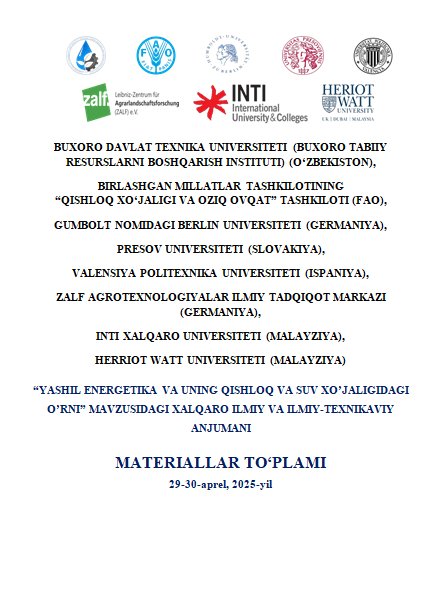QUYOSH TERMOKIMYOVIY SIKLIDA ISHTIROK ETUVCHI METALL OKSIDLARNING GIBBS ERKENERGIYASI TAHLILI VA UNING VODOROD ISHLAB CHIQISHDA AHAMIYATI
Keywords:
Quyosh termokimyoviy jarayon, Metal oksidlar, CeO2, ZnO, Redoks sikllari, Gibbs energiyasi.Abstract
Quyosh termokimyoviy jarayonlar samarali quyosh yoqilg‘isini ishlab chiqarishda muhim rol o‘ynaydi, bunda metall oksidlar asosidagi redoks sikllari katta ahamiyatga ega. Ushbu tadqiqotda CeO₂ ning ikki bosqichli termokimyoviy reaksiyalarda ZnO ga nisbatan afzalliklari o‘rganildi, ayniqsa kamaytirish harorati, oksidlanish kinetikasi, barqarorlik va kislorod saqlash qobiliyati bo‘yicha. CeO₂, pastroq kamaytirish harorati (~800°C), tezroq oksidlanish kinetikasi va sinterlashga chidamliligi bilan yuqori samaradorlikni ko‘rsatadi. Biroq, bu afzalliklarga qaramay, katalitik faollikni oshirish va redoks sikl barqarorligini yaxshilash zarurati mavjud. CeO₂ ning samaradorligini maksimal darajada oshirish va uning cheklovlarini bartaraf etish uchun yanada chuqurroq tadqiqotlar o‘tkazish zarur. Shuningdek, MoO₂/Mo va SnO₂/Sn kabi metall-oksid tizimlari yuqori haroratlarni talab qilsa-da, quyosh yoqilg‘isini ishlab chiqarishda va amalga oshirishda istiqbolli potentsialga ega. Bu tizimlar bo‘yicha Gibbs erkenergiyasi tahlili va tajriba natijalarining taqqoslanishi ularning amalga oshirilishi va samaradorligi haqida batafsil ma'lumot beradi.
References
1. Sundaram, S., Smith, L. M. (2020). Thermodynamics of Metal Oxides Solar Thermochemical Cycles. Journal of Renewable and Sustainable Energy, 12(4), 1041-1050.
2. Smith, P., Williams, D. (2019). Gibbs Free Energy and its Role Thermochemical Water Splitting. International Journal of Hydrogen Energy, 44(12), 12345-12352.
3. Yadav, R., Sharma, S. (2021). Role of Metal Oxides Hydrogen Production via Solar Thermochemical Cycles. Solar Energy Materials Solar Cells, 215, 110672.
4. Zhang, L., Li, S. (2018). Analysis of Thermodynamic Cycles Solar Hydrogen Production Systems. Energy Reports, 4, 280-289.
5. Chen, J., Li, Y. (2019). Thermodynamic Optimization of Metal Oxide Reactors for Solar Hydrogen Production. Renewable Energy, 134, 457-465.
6. Nguyen, A., Lee, K. (2020). Metal Oxides Solar Thermochemical Hydrogen Production: A Comprehensive Review. Materials Today Energy, 17, 100467.
7. M. Sturzenegger and P. Nüesch, ‘Efficiency analysis for a manganese-oxide-based thermochemical cycle’, Energy, vol. 24, no. 11, pp. 959–970, 1999
8. C. Perkins and A. W. Weimer, ‘Likely near-term solar-thermal water splitting technologies’, Int. J. Hydrogen Energy, vol. 29, no. 15, pp. 1587–1599, 2004, doi: 10.1016/j.ijhydene.2004.02.019.
9. N. Nakamura, H. Miyaoka, T. Ichikawa, and Y. Kojima, ‘Hydrogen production via thermochemical water-splitting by lithium redox reaction’, J. Alloys Compd., vol. 580, no. SUPPL1, 2013,
10. S. Kaneco, H. Kurimoto, K. Ohta, T. Mizuno, and A. Saji, ‘Photocatalytic reduction of CO2 using TiO2 powders liquid CO2 medium’, J. Photochem. Photobiol. A Chem., vol. 109, no. 1, pp. 59–63, Aug. 1997, doi: 10.1016/S1010-6030(97)00107-X.
11. T. Kodama, High-temperature solar chemistry for converting solar heat to chemical fuels, vol. 29, no. 6. 2003.
12. A. Kogan, ‘Direct solar thermal splitting of water and on-site separation of the products-IV. Development of porous ceramic membranes for a solar thermal water-splitting reactor’, Int. J. Hydrogen Energy, vol. 25, no. 11, pp. 1043–1050, 2000, doi: 10.1016/S0360-3199(00)00024-0.
13. Juraev, F., Ibodov, N., Sharipova, D., Do‘stova, S., Avliyoqulov, M. (2024). Studying the technological process formation of mole drainage from a mole ripper. E3S Web of Conferences (Vol. 486, p. 03013). EDP Sciences.


